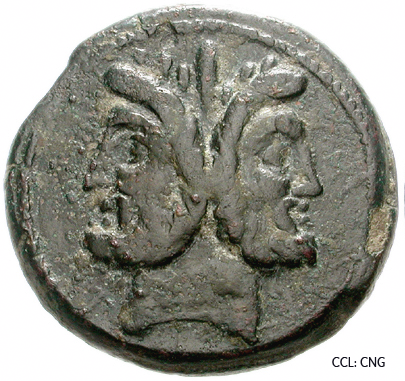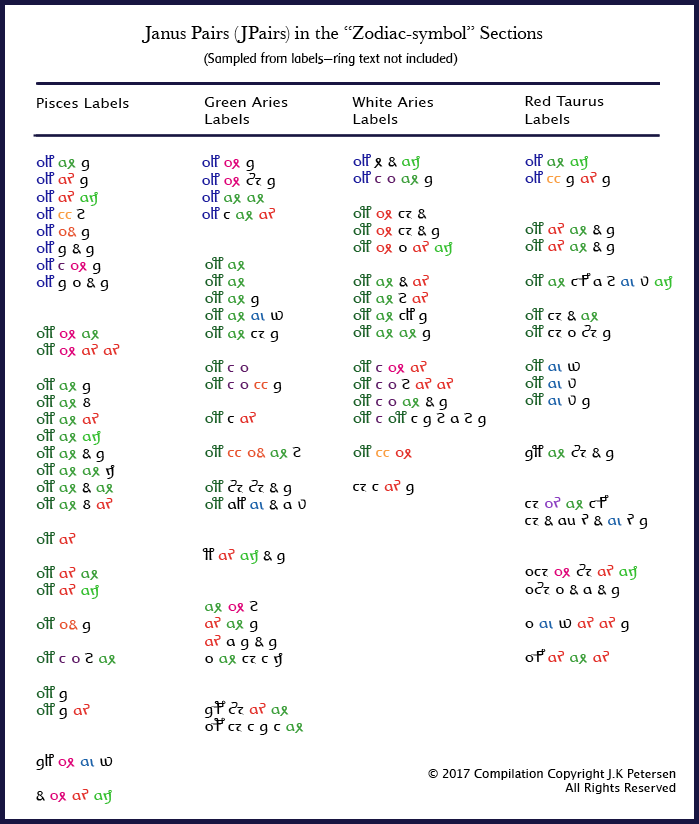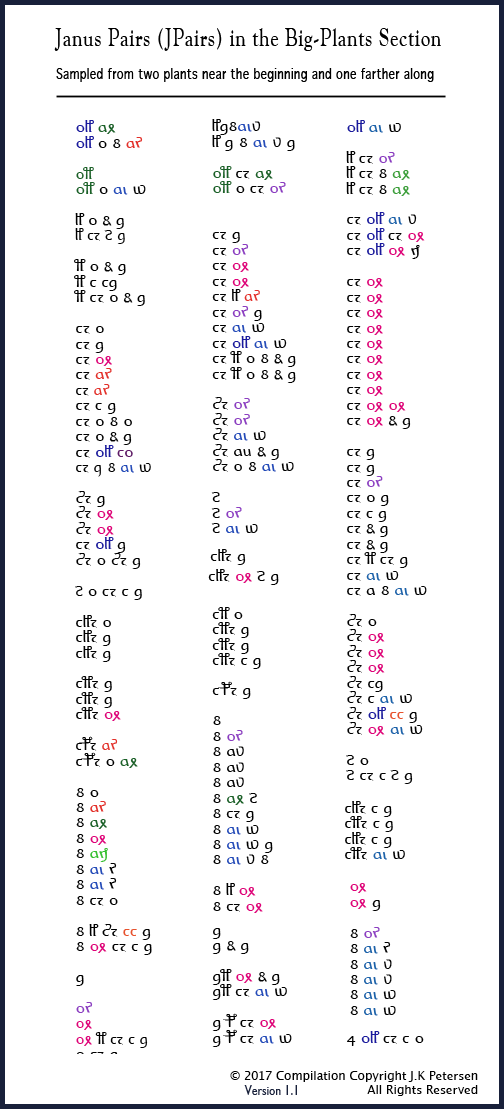16 September 2017
The Theme of Duality
You may have noticed pairing in the VMS… double crayfish, two sheets each of “Aries” and “Taurus”, 2 x 2 sets of 17 on the page that looks like a code wheel, but have you looked for pairing in the text?
In a previous post I introduced a group of glyphs I call The Gang of Four (if you haven’t read it, I strongly suggest it or this followup blog won’t make much sense). The Gang of Four is a subgroup of glyph-pairs that occur with great frequency within Vwords, and can also stand alone. Together with other glyphs with similar properties, I refer to them as Janus Pairs (or JPairs for short).
 Janus was the god of duality. He presided over beginnings and endings, doorways and passages. I like the analogy of Janus Pairs opening a window into the structure of the text.
Janus was the god of duality. He presided over beginnings and endings, doorways and passages. I like the analogy of Janus Pairs opening a window into the structure of the text.
Unlike English and many other languages, VMS glyphs cannot be shuffled in a multitude of ways to create a large pool of Vwords. Certain glyphs are found only in certain positions. This is true even if you evaluate them in pairs, which means the VMS is more positionally rigid than syllabic Asian languages, as well.
But pairs there are, and they form a disproportionately high percentage of letter combinations in Voynichese, with some interesting differences in where they are used.
The Prevalence of Janus Pairs
I cannot fully describe the dynamics of Janus Pairs in one blog or two, any more than one could describe the dynamics of English in one blog or two, but I can introduce them so you can visualize the patterns and make sense of follow-up articles.
Before posting examples, please be aware that I’ve spent years trying to discern which are pairs and which are monoglyphs (or ligatures). This is not easy (if it were, it would have been done a long time ago), but some can be confirmed by following them through the entire manuscript and noting where they fall in relation to other glyphs. It took me a while to figure out how to present them so the patterns could be readily seen.
The Gang of Four is an example of prevalent pairs that can be either free-standing or joined to other words, but it’s important to look at all the JPairs. Unfortunately, it’s not practical to post all of them, so I have selected examples from two sections.
Examples
The first group is from the “zodiac” section. There isn’t room for all the zodiac symbols, so I selected four as examples and chose only the text from the labels (not from the text inside the double rings). If this subject interests you, you can look at transcripts yourself to work out the others.
The second group is from the big-plants section. I’ve chosen two plants near the beginning, and one farther along.
Obviously, to understand the text, you have to analyze and compare all sections and all the Vords on each page, and I have spent years doing this and still have some unanswered questions, but the following charts should be enough to get the concepts across. Note that I have chopped three of the less common Pisces labels from the bottom of the chart, mostly to save space, but also to put the emphasis on the ones that are most prevalent and most illustrative of patterns. This doesn’t mean the three deleted Vords are unimportant.
I have color-coded pairs to make them stand out because I’ve seen so many decryption attempts that don’t take them into account. These charts are not designed to reveal the meaning behind the text, that is best done by organizing them in several different ways and placing them side-by-side on a very long table. Their purpose is to illustrate
- fundamental positional patterns,
- pair composition,
- pair frequency,
- order of glyphs within pairs,
- and differences between the text in two different sections of the manuscript.
So here is the first set of Janus Pairs, from the zodiac section:
I’ve collected samples of text in a number of languages to compare to these patterns (which is another long subject, possibly too long for a blog).
Here is the second chart, with examples from the big-plants section (note that a few Vords are chopped from the bottom of the first column due to space constraints).
You can immediately see that they differ in form and content from the zodiac-symbol vords but that there are structural similarities in where glyphs appear in specific vords (note that I am not certain aj is a Janus Pair, it can sometimes be oj and may be two separate glyphs).
Summary
Even though these are only small excerpts, there is much information to be gleaned from them.
Note the overall differences between zodiac Vords and plant Vords. There is a high prevalence of ot and ok combinations in the zodiacs. In the plant section, one sees many Vords starting with EVA-ch, -sh, or d and few of those that are common in zodiacs. If EVA-ch is a ligature then it may also qualify as a pair.
These patterns are prevalent enough that it’s possible to make a few predictions about where vords are likely to appear in the manuscript. You can’t do it from these charts alone (although some of the patterns are more obvious than others), but it’s possible when all the tokens in the manuscript are evaluated together.
Note also that there are priorities in terms of glyph placement. An “o” glyph paired with EVA-l, -t or -r, for example, behaves differently from one that isn’t combined into a pair group. This might be one of the reasons the o-glyph is so frequent, and also suggests that some glyphs may be intended as monoglyphs or ligatures—their status may be determined by their position and relationships to other glyphs, which might explain the strict positional rules.
VMS text is highly structured, not at all random, and there is substructure within individual sections. As to how it relates to natural languages, I’ll discuss that in a future blog, after you’ve had time to digest this one.
J.K. Petersen
© Copyright 2017 J.K. Petersen, All Rights Reserved


